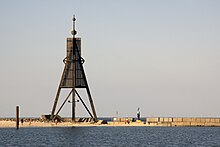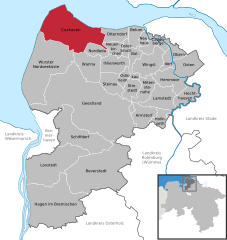Cuxhaven
| Cuxhaven | ||
|---|---|---|

Kugelbake, symbol of Cuxhaven
|
||
|
||
| Coordinates: 53°51′40″N 08°41′40″E / 53.86111°N 8.69444°ECoordinates: 53°51′40″N 08°41′40″E / 53.86111°N 8.69444°E | ||
| Country | Germany | |
| State | Lower Saxony | |
| District | Cuxhaven | |
| Government | ||
| • Mayor | Ulrich Getsch (independent) | |
| Area | ||
| • Total | 161.91 km2 (62.51 sq mi) | |
| Population (2015-12-31) | ||
| • Total | 48,264 | |
| • Density | 300/km2 (770/sq mi) | |
| Time zone | CET/CEST (UTC+1/+2) | |
| Postal codes | 27472, 27474, 27476, 27478 | |
| Dialling codes | 04721-04724 | |
| Vehicle registration | CUX | |
| Website | www.cuxhaven.de | |
Cuxhaven (German pronunciation: [kʊksˈhaːfən]) is an independent town and seat of the Cuxhaven district, in Lower Saxony, Germany. The town includes the northernmost point of Lower Saxony. It is situated on the shore of the North Sea at the mouth of the Elbe River. Cuxhaven has a footprint of 14 kilometres (9 miles) (east-west) by 7 km (4 mi) (north-south). Its town quarters Duhnen, Döse and Sahlenburg are especially popular vacation spots on the North Sea and home to about 52,000 residents.
Cuxhaven is home to an important fisherman's wharf and ship registration point for Hamburg as well as the Kiel Canal until 2008. Tourism is also of great importance. The city and its precursor Ritzebüttel belonged to Hamburg from the 13th century until 1937. The island of Neuwerk, a Hamburg dependency, is located just northwest of Cuxhaven in the North Sea. The city's symbol, known as the Kugelbake, is a beacon once used as a lighthouse; the wooden landmark on the mouth of the Elbe marks the boundary between the river and the North Sea and also adorns the city's coat of arms.
Ritzebüttel, today a part of Cuxhaven, belonged to the Land of Hadeln, first an exclave of the younger Duchy of Saxony and after its de facto dynastic partition in 1296 of the Duchy of Saxe-Lauenburg, established de jure in 1260. In 1394 the city of Hamburg conquered the fortress of Ritzebüttel and made it its stronghold to protect the estuary of the river Elbe, which connects that city with the open sea.
...
Wikipedia




